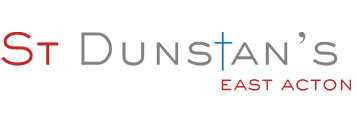Historic Building
Historical context
Acton was still predominantly rural in the 1870s but it was urbanising rapidly. East Acton had no church of its own, Sunday worship taking place under cramped conditions in what is now East Acton Primary School.
The decision to build and finance a new church for East Acton was made in 1876 by the Worshipful Company of Goldsmiths, a major landowner in Acton.
Urbanisation, then as now, was a contentious subject. The nineteenth-century clergy feared the spiritual vacuum that was developing in London’s fast-growing urban fringe; large property owners were expected to shoulder at least some responsibility for filling the void.
A press report of a speech made by the Bishop of London at the St Dunstan’s stone-laying ceremony in 1878 underlines this point. The bishop praised the Goldsmiths’ Company for setting an example to other property owners and noted that:
Why St Dunstan?
Dunstan is the patron saint of the Goldsmiths’ Company, so it would have seemed natural for the new church and parish to be dedicated to him.
Dunstan (909 - 988) was a pivotal figure in the development of the church in the years following the death of King Alfred. As Archbishop of Canterbury, Dunstan was responsible for the reformation of the monasteries – one of the key developments of his time. Aside from his clerical duties, he was also a skilled musician, painter and craftsman in precious metals.
But he was a controversial figure too. Victorian scholars sometimes painted an unsympathetic picture of Dunstan, casting him, probably wrongly, as a crusader against the married clergy.
The desire of the Goldsmiths’ Company to dedicate the new church to St. Dunstan evidently raised eyebrows among some senior clergy at the time. A letter from the Bishop of London’s office to the Goldsmith’s Company dated 27 March 1878, records that the Bishop had ‘…no objection to the dedication of the church in the name of St. Dunstan, who was really a great man in his way’.
Organ
The organ at St Dunstan’s is an instrument of which the church can be justly proud
The organ that now stands in the north chapel of the church was a gift to the newly consecrated building in 1879 by John Norbury, Prime Warden of the Goldsmiths’ Company. No one is quite sure where its home had been up to that point, for it was not new when the church acquired it. The organ as it was in 1879 was built by Bryceson and consisted of the present Great and most of the Swell. So it stood, in the west end of the church in a wooden gallery until 1913, when a decision was made to move the organ to the position that it occupies today. During this removal, the case was narrowed owing to the size of the chapel into which it was put. At the same time, the builders, William Hill & Sons, added a superb vox angelica to the swell organ which not only enhanced the liturgical use of the organ but made possible the performance of a great deal more of the romantic organ music that was available.
Hill came to be associated with the organ once again when it was enlarged in 1924. The company provided a four-stop choir organ of the following: Dulciana 8; Lieblich Gedeckt 8; Saube Flute 4; Clarinet 8; with sub octave and super octave. Hill also provided a spare slide on the new choir sound board and prepared an unmarked draw stop at the console. Hill also completed the pedal organ, providing a prepared for pedal reed.
The new three-manual console was fitted with 58-note keyboards, the extra two notes being very useful when the organ is being used to perform modern French music.
Today, the organ is undoubtedly a Hill in character. It is an exceptionally versatile instrument, providing organists with the freedom to perform the entire organ repertoire from Buxtehude to Langlais. The organ’s full-bodied romantic registers and ravishingly beautiful Bryceson diapason chorus have left the church with an instrument of which it can be justly proud.
St Dunstan’s church is an Acton landmark. Designed in the Gothic revival style by the architect R Hesketh, it was built and endowed by the Goldsmiths’ Company, one of the twelve great livery companies of the City of London. The church was completed in 1879 at a cost of £14,000.
Construction was rapid given the size and complexity of the building. The first stone was laid on Saturday 11 May, 1878; the church, capable of accommodating more than 800 people, was consecrated just 14 months later. According to a contemporary report, construction was completed ‘without the slightest accident to any one’ – a remarkable achievement by Victorian standards.
With its brilliant red brickwork, fine Bath stone detailing and distinctive octagonal ‘broach’ spire towering 136 feet above the hayfields, St Dunstan’s would have made an enormous impact in its then rural surroundings. Consecration took place on Tuesday 22nd July, 1879. The sermon was read by the Lord Bishop of London and admission to the ceremony was by ticket.
Regular services commenced the following Sunday, 27 July. There were two services that day: at 11am (with Holy Communion administered after the service), and at 6.30pm. The preacher at the evening service was the Vicar Designate, Rev T. M. Hayter, who went on to serve the parish for 28 years.
‘One great cause of the spiritual destitution of the Metropolis was that, from the rapid increase of building, masses of people were often gathered together without any means of worshipping God, and were allowed to go on without spiritual provision till they ceased to feel the need of it. The Goldsmiths’ Company had determined that this should not be the case on their property in Acton. They had done well, and in the name of the Church he congratulated them on this day’s work.’



